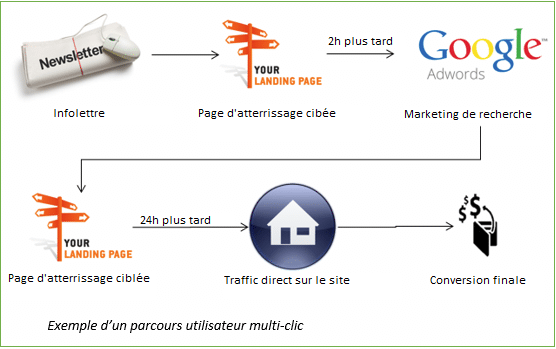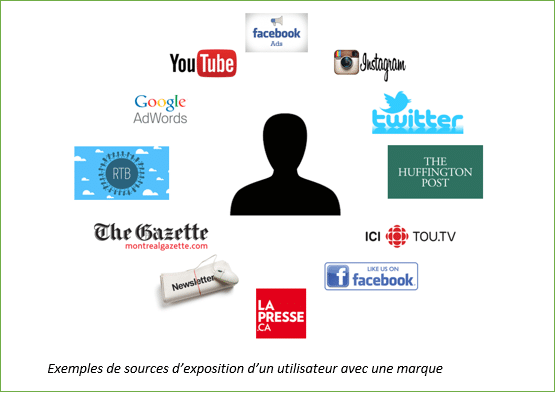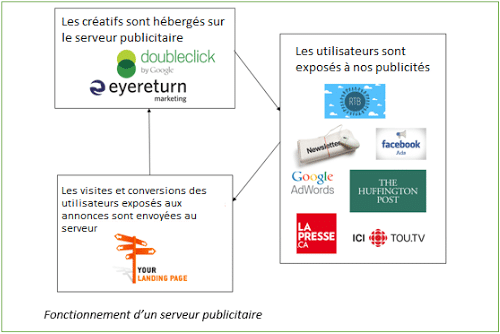Digital Media Practice Lead
Getting rid of “post-click” attribution
Digital Media Practice Lead
In today's world of web marketing, we track almost every action taken on a site through different tools. These actions can be measured in several ways and the different elements that impact them must be analyzed accordingly. Online, users can be reached by more than ten sources for the same advertiser. Post-click attribution analyzes only the user's last interaction with the media before performing a desired action. It thus omits the overview of an environment that is intended to be much more complex. In this article, we explore attribution methods for linking measured conversions to business goals.
THE “SOFT” CONVERSION VS THE FINAL CONVERSION
We can determine different types of conversions on a website. To keep things simple, we'll divide them into two categories: soft conversion and final conversion. Final conversion is a conversion directly related to a business goal (like a purchase).
A "soft" conversion consists of an action that brings the user closer to the final conversion. For an e-commerce site, this may be adding an item to the shopping cart. Here are three ways to use it wisely:
- To optimize media placements. Some algorithms need a certain volume of conversions to be effective. In some cases, it is therefore preferable to optimize the "soft" conversion to obtain the best performance.
- When the final conversion is not measurable in real time . For example, the user who downloads an insurance or credit card form may see his request refused after analysis of the file. In this case, there is no direct return for the company since the user does not become a customer.
- To identify bottlenecks in the conversion funnel . If all the steps of a payment process are followed, one can identify the step or steps that are problematic. For example, if a process requires users to register to make a purchase, this may discourage some users. The data collected could demonstrate the importance of implementing a purchase process without registration.
SEARCH MARKETING CONVERSION
Web marketing was mainly about search marketing in the early 2000s. We started by associating conversion in a simplistic way: users clicked on an ad, then a certain number of them performed the desired action on the site. of destination: a “soft” or final conversion. In search marketing, as the user expresses an intention with his choice of keywords, he is expected to be ready to perform an action or actions on the landing page.
Let's take the example of someone who searches for “a pair of jeans on sale”. He might click on an ad promoting a discount on jeans! Once on the site, he will want to find the jeans on sale and will probably add some to his basket. In this case, he will have accomplished a “soft” conversion. If the user continues the process by purchasing the jeans, he will complete a final conversion.
ATTRIBUTION: WHO DESERVES IT?
What about attribution if our user visits a website multiple times? Early models attributed the conversion to the last source that led to the conversion (last click). This type of model is consistent when the campaign objective is to get a direct response from the user, such as entering a simple contest.

It is now accepted that this model is not suitable for a more complex conversion. For example, a user receives, in the morning, a newsletter from a clothing site announcing a promotion. Due to lack of time, he only goes to the client's site for a few seconds and leaves quickly to get to work. At lunchtime, however, he returns to the site via search marketing, shops online and finally, the next day, comes back to the site directly and completes his purchase. We can clearly see here that the last click did not encourage a purchase!

We are talking here about conversions following the visit to the website or post-click conversion. To determine if there has been more than one post-click conversion, an attribution window must be determined. For an item like jeans, we can consider a period of 48 hours between the first visit and the conversion. For booking a trip or buying a computer, we could use a larger window (we imagine a longer purchasing process). There are three types of post-click conversions to be distinguished:
- Last Click : This is the source that is responsible for the last visit to the website before the conversion. In this category, we often find direct visits, as well as visits via the use of branded keywords on search engines ( branded queries ).
- First Click : This is the source that is responsible for the first visit to the website in the attribution period prior to conversion. Here we find visits from social media, as well as Display visits or through the use of more generic keywords.
- Assisted click : these are all the visits that take place between the first and the last conversion. In the example given, we will say that the newsletter obtained a first-click conversion, the search marketing will have obtained an assisted conversion and the last-click conversion will be attributed to direct traffic to the site. To calculate an ROI per source, we must then allocate a portion of the value of the transaction to each of our traffic sources. In some cases, a higher value will be assigned to the first or last click. Other advertisers may choose to assign equal value to each source. It is up to the advertiser to build a model that will be consistent with their business objectives (and we can of course support them in this task ;).
DISPLAY CONVERSION
Google introduced the Google Display Network within the Adwords platform so that you can buy banners on the networks in a similar way to how you buy search marketing. Thus, conversions were counted only after a user clicked on an ad and then performed a desired action. By the way, even today, the core metrics in Adwords still measure post-click conversions on a last click model .
In 2016, the reality for Display marketing is quite different. Users click less and less on banners. What is most important is exposing the user to the brand. It should be remembered that paid marketing is not solely responsible for generating conversions. The impact of social media or sponsorship at a public event will enhance the effect of the campaigns.

A user can be influenced by brands via several sources of exposure and digital levers. This is why a digital media plan can include programmatic buying via Google Adwords, an RTB platform or Facebook Ads, a premium purchase on LaPresse.ca, the Huffington Post, MontrealGazette.com or Tou.tv, sending newsletters and posts on social media such as Facebook, Twitter, Instagram and YouTube. Some media buys are aimed at raising awareness of a promotion, while others will be conversion-focused. The problem is to be able to attribute the conversions to the right source.
If premium placements are influencing our brand's search volume and our Google Search post-click conversions suddenly increase, who gets the credit? This is a nice puzzle!
POSSIBLE SOLUTIONS FOR AD SERVERS
When all ads are served from a single server, the server is able to link ad views and clicks to conversions. Thus, when a user has seen several advertisements before his conversion, we will be able to know all the sources which have succeeded in targeting this user in order to share the credit. Because different types of advertising purchases may have different purposes, the server allows us to measure our performance on the same basis across all platforms. For example, premium purchases could be chosen according to the lowest cost per visit to the website, or the lowest cost per "soft" conversion, two indicators of interest. Programmatic purchases, including Search and remarketing, will instead be optimized to maximize final conversions.

In such a context, we must be aware of the limits of our tracking . The rise in popularity of ad blocker add-ons (which prevent the deployment of ads) and the use of multiple devices by the same user (computer, laptop, tablet, smartphone) make it difficult to analyze server data. Despite this, we must bet on the fact that on the web, we mainly work with relative measurements rather than exact data . If the ad server reports that I'm getting twice as many conversions through the contextual tactic on Adwords than the contextual tactic on an RTB network, I can assume that my budget will be spent more efficiently on Adwords.
We conducted a case study quantitatively demonstrating the importance of post-view attribution in campaign optimization, read more here !

-1.png)
-1.png)






